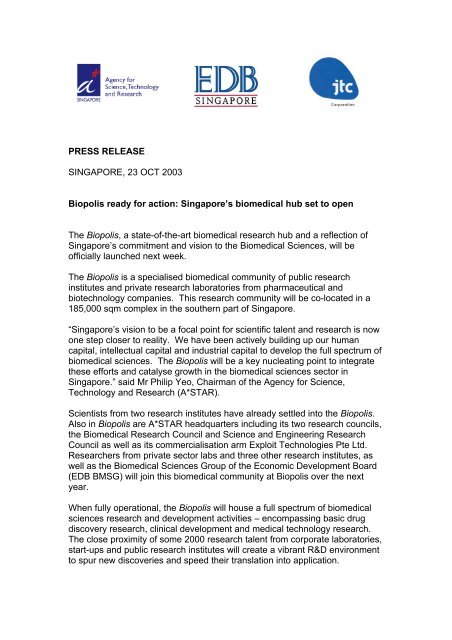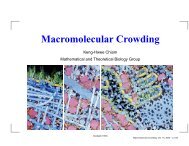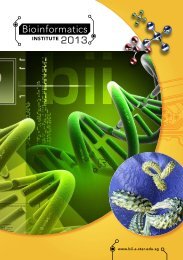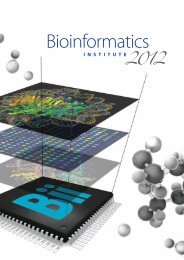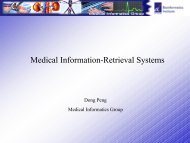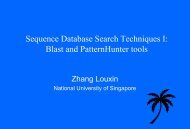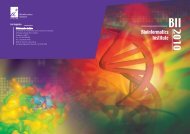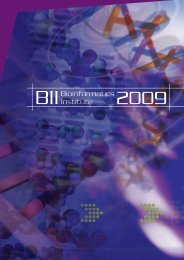Biopolis Press Release - Bioinformatics Institute - A*Star
Biopolis Press Release - Bioinformatics Institute - A*Star
Biopolis Press Release - Bioinformatics Institute - A*Star
You also want an ePaper? Increase the reach of your titles
YUMPU automatically turns print PDFs into web optimized ePapers that Google loves.
Public and private sector researchFive A*STAR research institutes - the <strong>Bioinformatics</strong> <strong>Institute</strong> (BII),Bioprocessing Technology <strong>Institute</strong> (BTI), Genome <strong>Institute</strong> of Singapore(GIS), <strong>Institute</strong> of Bioengineering and Nanotechnology (IBN) and the <strong>Institute</strong>of Molecular and Cell Biology (IMCB) will be housed at the <strong>Biopolis</strong>.BII and GIS have moved into the Matrix and Genome buildings at the <strong>Biopolis</strong>in September 2003. The other three biomedical research institutes will bemoving into <strong>Biopolis</strong> buildings called Centros, Proteos and Nanos by the firstquarter of 2004. These A*STAR institutes will be a key anchor of expertise inbioinformatics, genomics, molecular biology, bioprocessing technology,bioengineering and nanotechnology.The Novartis <strong>Institute</strong> for Tropical Diseases (NITD) and biotech start-ups,Vanda Pharmaceuticals and Paradigm will also be moving into <strong>Biopolis</strong> bymid 2004. NITD will focus on advancing medical research in the treatmentand prevention of tropical diseases, particularly for multi-drug resistanttuberculosis and dengue fever.US-based Vanda Pharmaceuticals is an innovative drug developmentcompany that develops alternative therapeutic uses for compounds that areoff-patent or that have been unsuccessful in initial clinical trials. Vanda willemploy 10 to 12 scientists over the next 3 years.Cambridge-based Paradigm Therapeutics will be establishing a subsidiary inSingapore to accelerate development and further research in the area of drugtarget validation for central nervous system and metabolic diseases, includingchronic pain, neurodegeneration and obesity.These industry labs will take up residence at Chromos, one of two multitenantedblocks within the research hub. Helios, the second multi-tenantedlab is expected to be ready by the second quarter of 2004. These two multitenantedblocks will offer a total of 35,000 sqm of lab space to biomedicalR&D companies. JTC and the EDB BMSG are in discussions with other localand foreign companies to site their R&D operations there.Talent attraction, training and synergyThe co-location of industry R&D labs and clustering of A*STAR institutes isthe result of strategic design.“In the knowledge-intensive biomedical sciences sector, top scientific talent isthe rate-limiting factor to growth. Our institutes’ core charter is to trainmanpower and develop top-class capabilities. Locating companies in closeproximity to such expertise will create a healthy flow of talent and knowledgeinto the industry,” explains Mr Yeo.
The eventual density of talent will, in itself, be a draw for other establishedscientists, post-doctoral fellows and graduate students who are naturallyattracted to such vibrant R&D environments. “Singapore’s bright youngscholars who are pursuing their PhDs can expect to join this dynamiccommunity of researchers at <strong>Biopolis</strong>. We hope these scholars will developas leaders in research and drivers of growth in the biomedical industry,”added Mr Yeo, a strong proponent of training the future generation.Cross-disciplinary collaborations and cross-fertilisation of ideas are alsodesired outcomes of the frequent interactions within the <strong>Biopolis</strong> community atcommon meeting points and shared facilities.Shared FacilitiesA key feature of the <strong>Biopolis</strong> is the shared facilities that will be introduced inphases. The economies of scale would give researchers in both public andprivate sector labs access to state-of-the-art specialised scientific equipmentand facilities that individual labs would be hard-pressed to operateindividually. Common services and resources will also be centralised foreconomies of scale and greater operational efficiencies.Specialised shared facilities and services will be introduced in stages. Theseinclude flow cytometry, X-ray crystallography, nuclear magnetic resonance,electron microscopy, DNA sequencing, proteomics, histology, laboratorysupplies, media preparation, glassware washing and the animal resourcescentre.There are currently no laboratories in the research institutes operating atbiosafety level 3 (BSL3). However, <strong>Biopolis</strong> has also made provision for suchBSL3 facilities in future. The stringent requirements of such facilities are morerigorously met when they are purpose-built from scratch, as opposed toconversion or upgrading of existing facilities built for a lower biosafety level.The facilities are currently under construction, and will not be commissioneduntil they are fully validated for use and until staff are trained and certified.A veritable treasure trove of information will also be available at thebiomedical library currently under construction. The library will offerresearchers an excellent selection of scientific book titles, scientific journals,research manuals and records.To facilitate discussion and teaching, a 500-seater auditorium, four 250-seaterlecture theatres and meeting rooms complement the top-notch lab facilitiesavailable at the research complex.In addition to laboratories and the shared scientific facilities, one can expectoffice space, commercial establishments and amenities such as childcareservices, food and retail outlets to be introduced over time.
Sky bridges linking all the buildings of the <strong>Biopolis</strong> and open green spacesprovide meeting points and a conducive environment for researchers togather, mingle and exchange ideas. This clustering of biomedical researchtalent and activities is designed to nurture multi-disciplinary collaboration,which is a key element of modern R&D.<strong>Biopolis</strong> – signature development of one-north<strong>Biopolis</strong> is developed by JTC at a cost of SGD500 million. It is strategicallylocated close to the National University of Singapore, the National UniversityHospital and the Singapore Science Parks, to encourage exchange betweenacademia and industry.The <strong>Biopolis</strong> is part of a larger development covering 200 hectares, one-north,that will also house Fusionpolis, a media and information technology hub, andprovide housing for scientists working nearby.Official launch of <strong>Biopolis</strong>The official launch of the <strong>Biopolis</strong> on 29 October 2003 will be a milestone inSingapore’s Biomedical Sciences sector and marks the start of more excitingtimes, not only for the researchers who work, live and play at the <strong>Biopolis</strong>, butalso for Singapore, an active global player in the Biomedical Sciences arena.###For media queries, please contact:Agency for Science, Technology and ResearchMs Sant KAURMs Geraldine WANGDID : (65) 6826-6335DID: (65) 6826-6343Email: sant_kaur@a-star. edu.sg Email: geraldine_wang@a-star.edu.sgJTCMs TANG Shuk YeeDID: (65) 6883 3064Email: tangsy@jtc.gov.sgEDB BMSGMs Janet THIERRENDID: (65) 6832 6663Email: janett@edb.gov.sg


